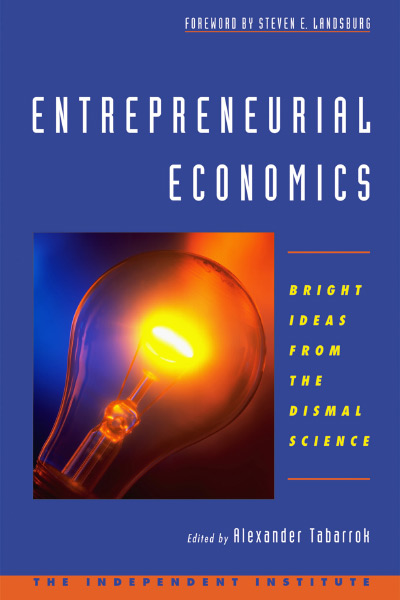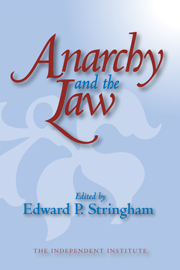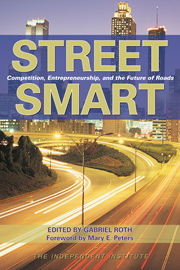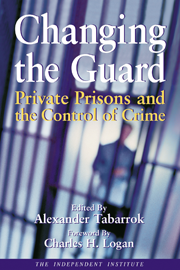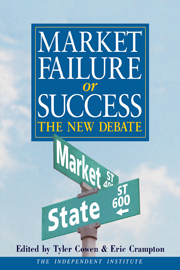| List Price: | ||
| Price: | $17.95 | |
| Discount: | $107.05 (Save 86%) |
| List Price: | ||
| Price: | $17.95 | |
| Discount: | $107.05 (Save 86%) |
Overview
Economics has long labored under the misnomer, “the dismal science,” yet Entrepreneurial Economics shows that it is anything but dismal! Economic thinking is indispensable not only for understanding the world of human affairs, but also for improving it.
Entrepreneurial Economics ingeniously applies simple economic principles to improve our health, wealth, security and happiness. Leading scholars take on the problems of genetic testing, patents, health and wealth insurance, legal gridlock, probation and parole, urban transit, intelligence gathering, bankruptcy, investor protection, and even the shortage of human organs.
Entrepreneurs, reformers and visionaries have often turned a blind eye towards economics, only to see their efforts fail. Entrepreneurial Economics now provides the crucial economic insights for any endeavor.
Entrepreneurial Economics gives students valuable insights into the power, scope and relevance of economic thinking; inspires economists to bring the tools of their trade to bear on a wider range of problems; offers promising new solutions to social problems built upon time-tested principles; encourages business people to identify innovative—and potentially very profitable—ideas waiting for entrepreneurship and provides anyone with an intriguing, inspiring and irreplaceable resource for seeking real solutions to complex social problems.
Want to really change the world? Entrepreneurial Economics clearly demonstrates how practitioners of “the dismal science” are doing just that.
Contents
Foreword: The Entrepreneurial Economist
Steven Landsburg
Chapter 1: Introduction
Alexander Tabarrok
Part I: Wealth and Health Insurance
Chapter 2: Macro Markets and Financial Security
Stefano Athanasoulis, Robert Shiller and Eric van Wincoop
Chapter 3: Gene Insurance
Alexander Tabarrok
Chapter 4: Time-Consistent Health Insurance
John H. Cochrane
Part II: The Use of Information in Markets
Chapter 5: Decision Markets
Robin D. Hanson
Part III: The Shortage of Human Organs
Chapter 6: A Market for Organs
Andy H. Barnett, Roger D. Blair, David L. Kaserman
Chapter 7: The Organ Shortage: A Tragedy of the Commons
Alexander Tabarrok
Part IV: Efficient Justice
Chapter 8: A Modest Proposal to Improve Judicial Incentives
Steven Landsburg
Chapter 9: Privatizing Probation and Parole
Morgan Reynolds
Chapter 10: More Justice for Less Money
David Friedman
Part V: Bankruptcy and Securities Regulation
Chapter 11: Improving Bankruptcy Procedure
Philippe Aghion, Oliver Hart, John Moore
Chapter 12: Empowering Investors: A Market Approach to Securities Regulation
Roberta Romano
Part VI: Patents without Monopoly
Chapter 13: Patent Buyouts: A Mechanism for Encouraging Innovation
Michael Kremer
Part VI: Urban Transit
Chapter 14: Curb Rights: Eliciting Competition and Entrepreneurship in Urban Transit
Daniel B. Klein, Adrian T. Moore, Binyam Reja
Index
Detailed Summary
- Economic downturns: The creation of national-income markets could enable households to hedge against loss of income due to recession. Similar markets could help create individualized income-protection insurance, making traditional government unemployment-insurance obsolete. (Chapter 2)
- Health insurance: Gene insurance could protect people against premium increases that could result when genetic testing reveals a predisposition towards specific diseases (Chapter 3). Highly flexible “time-consistent” insurance policies could provide coverage without locking insureds into a particular insurer (Chapter 4).
- Public decision-making: Economic decision-makers can look to market prices for guidance in comparing trade-offs and predicting outcomes, but voters and policymakers have no similarly reliable guidelines to help in public decision-making. But, simulated public-policy “markets,” which would efficiently aggregate information, could provide better guidance than news reports and opinion polls. (Chapter 5)
- Human organ shortages: A free market in human organs (currently banned by federal law) would quickly end the human organ shortage and does not imply that organs would go only to the wealthy. Organ shortages might also be eliminated with a “no give, no take” rule that makes donor organs available only to those who pledge to bequeath their organs (Chapter 6 and 7).
- Making justice pay: Judges could be given “bounty” incentives to parole only low-risk criminals (monetary bonuses and penalties conditioned on parolee behavior) (Chapter 8). Parolees could be given better incentives to obey parole conditions (parole bail) (Chapter 9).
- Class-action gridlock: The fair strategy for cutting a cake—one person cuts the cake and the other chooses which piece to eat—can be applied to improve the courts. Instead of seeking one-size-fits-all settlements, plaintiff lawyers could seek separate damages for a subset of plaintiffs, while defense lawyers choose which cases will be litigated. (Chapter 10)
- Bankruptcy reform: Current procedures are often slow and economically destructive of company assets. Giving shareholders and junior debt-holders options to buy out senior debt holders and subsequently creating a unified group of shareholders with equal voting rights would align the interests of all stakeholders and hasten a low-cost corporate reorganization. (Chapter 11)
- Securities regulation: Federal securities regulation is highly bureaucratic and slow to improve. Competitive federalism, however, would create competition between state regulators, allowing companies (and states) to find the optimal regulatory system. (Chapter 12)
- Patents reform: Patents spur innovation but the patented product is priced above competitive levels. Patent buyouts by governments or non-profit organizations could deliver innovation and competitive prices. (Chapter 13)
- Urban transit: Transit passengers would be best served by having regular bus lines and flexible jitney service. But if jitneys scoop up the bus passengers, buses can be driven out of business. Curb rights would allow both modes of transit to coexist profitably to the great benefit of city residents. (Chapter 14)
Economics has long labored under the misnomer, “the dismal science,” yet economics is a fascinating and essential aid for understanding the world—and for improving it. More than 200 years after its birth, economics still offers new and important insights for improving human health, security, prosperity, and happiness, as is demonstrated in Entrepreneurial Economics: Bright Ideas from the Dismal Science, edited by Alexander Tabarrok (Oxford University Press/The Independent Institute).
Entrepreneurial Economics is a treasure trove of promising solutions to a vast array of social and economic problems, old and new. Through the novel application of basic economic principles, twenty economists examine such diverse issues as genetic testing, patents, health and wealth insurance, legal gridlock, probation and parole, urban transit, information aggregation, bankruptcy, investor protection, and even the shortage of human organs.
Wealth and Health Insurance
Although companies today possess many effective risk-management tools, households still must cope with very large economic risks that are outside of their control. Recently, for example, South Koreans and Argentinians have faced severe shocks to their incomes from macro-economic events. Similarly, most people have a very large fraction of their wealth bound up in their home. But housing prices can rise and fall dramatically thereby causing huge swings in a homeowner’s wealth and making future planning difficult. In chapter 2, Stefano Athanasoulis, Robert Shiller and Eric van Wincoop explain how national-income (and other macro markets) could be created to enable individuals to hedge against the risk of macroeconomic downturns. Markets for hedging against occupational risks, they further explain, could also be created. As Alexander Tabarrok explains in the introduction, dentists could hedge in these markets against the risk (to dentists!) that some new anti-cavity innovation would erode their income. Policymakers might even discover that private income markets could replace our current, inefficient system of government unemployment insurance. National-income markets could also make politicians more concerned with the long-run impacts of their policies.
Health and life insurance could also be made more efficient and more equitable using new markets. In chapter 3, Alexander Tabarrok shows how gene insurance would solve the problem of some individuals facing higher health insurance premiums if genetic testing revealed a disease-associated gene. Before taking a genetic test an individual could buy insurance to cover any increase in premiums. Instead of shunning so-called bad risks, insurers would eagerly compete to offer policies to all individuals regardless of their genetic makeup. In chapter 4, John Cochrane shows how markets could also solve the problem of unexpected premium increases stemming from any source. Cochrane’ s time-consistent insurance contracts would allow individuals to guarantee insurance coverage without locking themselves to one insurance firm.
Improving Public Decisionmaking
Markets collect and integrate information remarkably well. Market prices, for example, reflect the decisions of thousands of highly motivated consumers, producers, and investors. Forecasts based on market prices tend to be far more accurate than forecasts that ignore them. If market prices could somehow aggregate information about government policies, then policymakers and voters would have a better basis for making decisions than the questionable sources they often rely upon. In chapter 5, Robin Hanson explains how new markets could be created to provide more reliable information on public policy. If Hanson is right, then perhaps one day, instead of quoting an expert, New York Times editorials will refer to the latest quote on “Health Care Plan A” available in the business pages.
The Shortage of Human Organs
Every year, thousands of people die while waiting for an organ transplant, even though healthy organs are buried or burned. In chapter 6, Andy Barnett, Roger Blair, and David Kaserman suggest eliminating current laws that forbid the sale of human organs. They also confront objections to a futures market in human organs and describe the superiority of the market approach to what superficially looks like a similar proposal, compensating donor families.
Prices are not the only way in which the market for organs can be made to clear. In chapter 7, Alexander Tabarrok discusses some possible problems with using price as a clearing mechanism. Instead of viewing the human organ shortage as a pricing problem, he argues that it is a classic “tragedy of the commons” problem whose solution is “enclosure,” i.e., restriction of access to organ transplants to those who previously agreed to be organ donors—in short, a “no give, no take” rule. Your pledge to bequeath an organ is the premium you pay for the right to receive a needed organ.
Making Justice Pay
Steven Landsburg’s chapter on the bail bond system nicely illustrates how the novel application of economic principles can enhance the criminal justice system. Landsburg proposes a system to give judges greater incentive to release the lowest risk criminal defendants. Under his plan, judges would be paid “bounties” when released defendants do not commit crimes and be fined when they do. By adjusting the fines and bounties, society can choose how strict or lenient it wants the bail system to be while maintaining strong incentives to release only those defendants least likely to commit future crimes. Landsburg’s plan need not cost taxpayers a dime, since fines and bounties can be uniformly raised or lowered so that, on average, judges’ salaries do not change.
About 38 percent of those arrested for felonies are already on parole, probation or pre-trial release for another crime. In chapter 9, Morgan Reynolds proposes that parolees be required to post bail as a condition of parole. The risk of bail forfeiture would both raise the costs of crime to the parolee and give bondsmen a strong incentive to help parolees walk the straight and narrow.
Because class-action suits often involve thousands of plaintiffs, letting each plaintiff have his day in court is time consuming and expensive. David Friedman in Chapter 10 proposes a unique method of settling disputes based upon the fair method for cutting a cake—you cut the cake and I choose which half I want! In Friedman’ s proposal the plaintiffs’ lawyer makes a claim for damages on behalf of each plaintiff and then defense lawyers choose which cases will be litigated. Plaintiffs with cases that go to trial will receive the trial award, while those with non-tried cases receive their claimed amount multiplied by the ratio of awarded damages to claimed damages in the tried subset. Lawyers for the defense will choose to litigate those cases with the most overclaimed damages, thereby driving down damages in the non-tried subset. Knowing this, the plaintiffs’ lawyer will try to make fair claims—i.e., claims equal to what a jury would actually award in a trial. Friedman’ s proposal could greatly simplify and expedite tens of thousands of cases now awaiting adjudication.
Bankruptcy and Securities Regulation
Bankruptcy is simple in principle but costly in practice, causing company assets to deteriorate even more. Phillippe Aghion, Oliver Hart, and John Moore (AHM) propose to significantly lower the costs of transferring ownership rights by, among other things, converting all debts into a single class of equity, thus eliminating conflicts that result from classes of debt holders having different voting rights. Management would also be allowed to submit bids, creating a more nuanced disciplining of management than under current bankruptcy procedures. AHM also suggest that firms be allowed to offer shareholders and lenders their own, perhaps unique, bankruptcy codes. Competition could produce better codes just as it produces better blue jeans.
Currently, the Federal government offers a one-size must fit-all system of securities regulation. In Chapter 12, Roberta Romano argues convincingly for competitive federalism, allowing each state to offer its own securities regulations while respecting those of other states. Because it is not obvious what the optimal securities regulations are, and because the optimal regulations may differ by company and circumstances, competition between state regulators would allow companies (and states) to find the most appropriate regulatory systems at reasonable prices.
Patents without Monopoly
In chapter 13, Michael Kremer presents an innovative plan to improve the U.S. patent system. Patents prevent copiers from using an inventor‘s ideas free of charge and thus increase the incentive to invent. But they also grant market power to the patent-holder, who can then charge higher than competitive prices. Kremer’ s proposal resolves this dilemma. If a government could estimate the sum of consumer surplus, profit and deadweight loss associated with a patent, it could easily solve the problem by buying the patent for that sum and placing it in the public domain. Such patent buyouts, Kremer explains, would eliminate the deadweight loss caused by monopoly pricing and raise the incentive to invest in research. Yet such a plan has obvious problems of information (how can the government know what the patent is worth?) and problems of incentives (the government might pay for patents based upon political pressure). To help eliminate these problems, Kremer proposes a creative use of auctions (see chapter 13 for the details!). Markets, not governments, would estimate the value of patents, and the public nature of the auction would help to alleviate the problem of government turpitude.
One virtue of Kremer’s idea is that it can be tried in small doses. Indeed it is not even necessary that the government be involved. Today consumers and foundations contribute billions of dollars directly to medical research. Perhaps some of these contributions would be better spent supporting research indirectly through a patent auction.
Urban Transit
In chapter 14, Daniel Klein, Adrian Moore, and Binyam Reja (KMR) explain how urban transit can be improved by making scheduled fixed-route transport economically compatible with jitney transport (essentially shared-ride cabs traveling along quasi-fixed routes). Ideally, jitneys and scheduled fixed-route transit are complementary. In practice, however, jitneys can impede fixed-route transport by swooping in just before scheduled service to grab up waiting customers. Such “claim-jumping” has driven some scheduled transportation out of the market, prompting some cities to ban jitneys. Other cities, often in developing countries with overburdened police and courts, have let jitneys run free at the expense of scheduled, fixed-route transport. Neither response is optimal.
KMR would resolve this dilemma by creating a new property right, “curb rights.” A curb right would give the owner the right to use a certain section of the curb to pick up and drop off transit passengers at a certain time. Curb rights would give owners of scheduled services the incentive to invest in getting customers while also avoid monopoly and would allow jitneys to retain their place in the transit system. Despite billions spent on public transit, city transportation remains a vexing problem in most American cities. Curb rights are a promising innovation that transcends the usual debate.
As a result, Entrepreneurial Economics gives valuable insights into the power, scope and relevance of economic thinking and provides an intriguing, inspiring and irreplaceable resource for seeking real solutions to complex social problems.
Praise
“The essays in Entrepreneurial Economics display economic ingenuity at its best, devoted to inventing market solutions for a remarkably wide range of public issues. The analysis is subtle and tends to be comprehensive; though the subjects are challenging, the exposition is lucid.”
—Milton Friedman, Nobel Laureate in Economic Science
“Provocative ideas whose times have (perhaps) come are found in Entrepreneurial Economics: Bright Ideas from the Dismal Science. The book is edited by economist Alexander Tabarrok, research director at The Independent Institute, and published by Oxford University Press. The book showcases 13 big new policy ideas, all of which feature market-based solutions.”
—Washington Post
“I thoroughly enjoyed Entrepreneurial Economics. . . . A very stimulating collection of ingenious ideas that can be characterized as market cures for market failure. A substantial number are promising as practical measures that can contribute to economic welfare, and all of them stimulate the imagination, promising to elicit new ideas from the reader.”
—William J. Baumol, Director, C.V. Starr Center for Applied Economics, Department of Economics, New York University
“Entrepreneurial Economics offers you lively, eye-opening, mind stretching applications of economic principles and analysis. Students who read it will confound teachers who haven’t.”
—Armen A. Alchian, Professor of Economics, UCLA
“I learned a lot reading Entrepreneurial Economics, and I’ll surely steal some of the ideas for use in future books and columns. I hope others steal them for use, not just entertainment. Unfortunately, there are no property rights in the ideas themselves. That suggests we’re not getting enough of them. Let’s cherish the ones we’ve got.”
—Steven E. Landsburg, Professor of Economics, University of Rochester
News
| “The Nobel Prize in Economic Science Goes to Banerjee, Duflo, and Kremer” Entrepreneurial Economics contributor Michael Kremer cited in Marginal Revolution | Mon., Oct. 14, 2019 |


